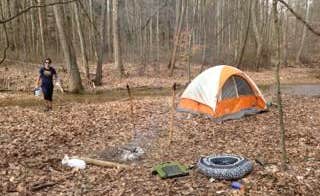Dispersed camping near Shepherdsville, Kentucky offers rugged, off-grid experiences approximately 20 miles south of Louisville. The area sits within the Ohio Valley region, creating distinct terrain features with limestone outcroppings and seasonal creek beds. Rustic camping opportunities extend primarily into southern Indiana, where backcountry sites require varying degrees of preparation depending on seasonal water availability and access conditions.
What to do
Trail exploration: The Knobstone Trail provides extensive hiking opportunities with significant elevation changes and natural features. "The entire park is just beautiful. It's very family friendly and quiet. The sites are spacious, and there are a lot of nature things to do," notes Susan C. about Knobstone Trail.
Fossil hunting: Search creek beds for fossils throughout the camping areas, particularly after rainfall when new specimens become exposed. "Everywhere you hike there are lovely vistas and lots of fossils on the trail and creek beds," according to one visitor's experience on the trails.
Wildlife observation: Spring and summer months offer opportunities to spot local wildlife, though campers should prepare for insects. Jackson Trailhead provides access to quieter observation areas away from developed campgrounds. "There's parking after a decrepit gravel road and suitable for camping. There are campsites along the trail just have to find them," explains loganx11.
What campers like
Solitude and seclusion: Hoosier National Forest offers remote camping experiences without crowds. "Big spot for almost any type of camper. Deep woods," reports Nathanyal C., highlighting the forest's capacity to accommodate various camping styles while maintaining a secluded atmosphere.
Physical challenge: The continuous elevation changes create a demanding but rewarding experience for hikers and backpackers. "Most people, even Hoosiers don't realize the Knobstone Trail exists. It's often referred to The Little AT by those who know about it. It's no walk in the park," explains Dave E.
Water features: Seasonal creeks and streams provide both practical resources and scenic elements throughout the camping areas. Water accessibility varies by season, with more reliable sources in spring months compared to late summer and fall.
What you should know
Seasonal water concerns: Late summer and fall months often bring reduced water availability. "You're never too far from water, although the quality may differ depending on the time of year," notes Maris H. about conditions along the trails.
Access challenges: Some locations have limited or difficult access points. As Desert B. discovered when trying to reach one area, "Maybe Google Maps took me to the wrong place. I drove back and forth on the road several times looking for this place. The only thing I found was what I believe was the entrance with a cable across it."
Wildlife precautions: Tick activity becomes particularly problematic in spring months. Appropriate clothing, regular checks, and repellents are necessary when camping in this region from April through summer.
Tips for camping with families
Site selection priorities: Families should prioritize campsites closer to trailheads to minimize hiking distances with children and gear. Jackson Trailhead offers several suitable options within reasonable walking distance from parking areas.
Water planning: Family groups require more water than solo campers or small groups. During dry months, plan to carry all necessary water rather than relying on natural sources, especially with children.
Activity preparation: Pack materials for fossil identification and exploration to engage children with the natural surroundings. Having field guides or printouts specific to the Ohio Valley region helps maximize educational opportunities.
Tips from RVers
Alternative options: Most dispersed camping near Shepherdsville does not accommodate RVs. Consider established campgrounds within 30 miles if traveling with larger vehicles, as the primitive sites primarily support tent camping or very small trailers at limited locations.
Road condition awareness: Access roads to many trailheads feature gravel surfaces with seasonal deterioration. Scout road conditions before attempting access with any trailer, even small ones, particularly after rainfall.
Supply planning: No hookups or services exist at dispersed sites. RVers staying at nearby established campgrounds should fully stock supplies before arrival, as remote locations offer limited resupply options within convenient driving distance.


